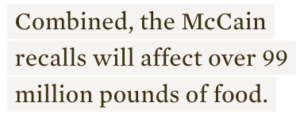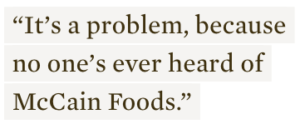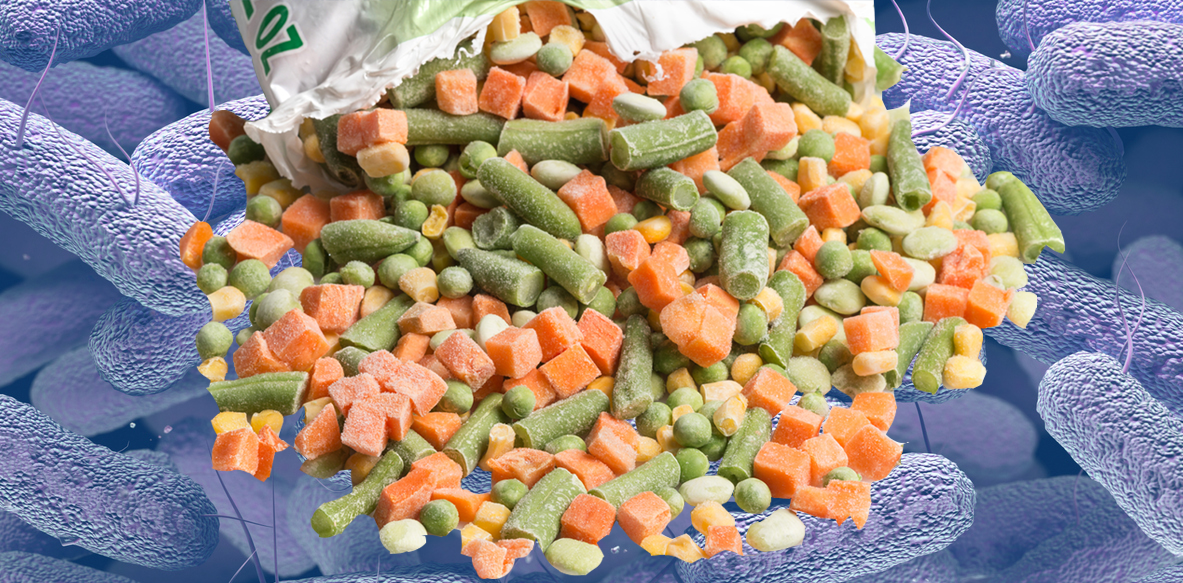New Food Economy: The biggest food recall of 2018 is one you still haven’t heard about
by Sam Bloch | January 3rd, 2019
How a prepared produce wholesaler quietly recalled 100 million pounds of potentially listeria-contaminated product without the public noticing.
In a year with some record-breaking recalls—from romaine to cake mix to ground beef—the one initiated by McCain Foods, which ran for six weeks in October and November, may be the largest, and most significant. Why haven’t you heard of it? Because it’s not about finished products, but commercial ingredients—the invisible mortar of the food system.
You might not know McCain, but you’ve probably eaten its food. The multi-billion-dollar foodservice corporation, based in Ontario, Canada, manufactures frozen foods—primarily potatoes, but also fruits and vegetables, pizzas, juices, and various oven meals—in 53 plants around the world. (It brags that one in every four French fries eaten globally is McCain.) Those branded products are sold in supermarkets, but the company also makes prepared ingredients, like processed fruits and vegetables, for plenty of commercial kitchens who go on to make foods of their own.
Now, think back to October: You may have read that a number of grocery stores, from Whole Foods to Walmart, pulled thousands of branded salads, wraps and burritos, from their shelves, out of concern over roasted corn and onion ingredients that may have been contaminated with Salmonella and Listeria monocytogenes.
 That was the end of the story for the grocers, who discarded—and, presumably stopped ordering—the products in question. But that action didn’t address the underlying source of the contamination: McCain’s processed produce, which had already been shipped out to wholesale customers across the country. In the six weeks that followed, the country’s two leading food regulators—the United States Department of Agriculture and the Food and Drug Administration—quietly oversaw the removal of dozens of other products that were also made with possibly tainted ingredients. They ran the gamut from branded freezer meals and ready-to-eat burritos to soups and sandwiches available in cafeterias and convenience stores across the country.
That was the end of the story for the grocers, who discarded—and, presumably stopped ordering—the products in question. But that action didn’t address the underlying source of the contamination: McCain’s processed produce, which had already been shipped out to wholesale customers across the country. In the six weeks that followed, the country’s two leading food regulators—the United States Department of Agriculture and the Food and Drug Administration—quietly oversaw the removal of dozens of other products that were also made with possibly tainted ingredients. They ran the gamut from branded freezer meals and ready-to-eat burritos to soups and sandwiches available in cafeterias and convenience stores across the country.
They include, for example, millions of Kashi bowls and Evol pastas, and tens of thousands of Beecher’s cheese dips. Over 210,000 pounds of frozen Philly cheesesteak sandwiches sold to airlines, delis and convenience stores. Almost one million packs of Safeway roasted corn, 178,000 pounds of diced peppers and onions for military rations, and 1,350 pounds of onion soup for restaurants and institutional kitchens in schools and hospitals. About 58,000 gas station pizzas. As many as 400,000 packs of Path of Life microwaveable quinoa.
What was wrong with all that food? Like the clamshell salads at Whole Foods, they were made with vegetables processed at a single McCain plant in Colton, California. Shortly after the grocers removed their salads, McCain announced a recall of everything it processed there—a variety of sautéed, fire-roasted and caramelized vegetables, including corn, onions, chiles, mushrooms, and peppers—due to a possible Salmonella and Listeria monocytogenes contamination that dated all the way back to January 1, 2016.
 During the period covered, according to FDA and USDA records, the plant supplied vegetables to at least thirty food companies. That’s a problem. Because when three years of ingredients get recalled, so do all of the foods made downstream that they went into—many of which are sold frozen, and won’t expire for years. All told, from the processed vegetables to finished products, the complete, three-year recall of the McCain plant will affect at least 146 food products, and over 99 million pounds of food, according to a New Food Economy review of USDA and FDA records.
During the period covered, according to FDA and USDA records, the plant supplied vegetables to at least thirty food companies. That’s a problem. Because when three years of ingredients get recalled, so do all of the foods made downstream that they went into—many of which are sold frozen, and won’t expire for years. All told, from the processed vegetables to finished products, the complete, three-year recall of the McCain plant will affect at least 146 food products, and over 99 million pounds of food, according to a New Food Economy review of USDA and FDA records.
That 99-million-pound figure is astonishing, enough to dwarf the year’s historic recall of ground beef by over a factor of eight. But it’s a conservative estimate. As I multiplied the number of cases ordered removed by the weight of each case—data provided in both USDA releases and FDA enforcement reports—there were instances where a product had multiple case weights. Take, for instance, the 259,000 cases of roasted zucchini—classified as a product of Jon-Lin, the company that owned the plant when it was bought by McCain in 2006—that were shipped in both 25-pound and 1,200-pound cases. When there was any ambiguity, I multiplied only by the smaller figure. (Neither agency responded to requests for comment.)
In this case, for example, I estimated it to be only around 6 million pounds of produce. But considering the massive, 1,200-pound pallets of roasted squash involved, the real number was potentially much higher—as much, in theory, as 310 million pounds of product. That’s a lot of zucchini. Now imagine how many more foods that zucchini was mixed into before the recall hit.
All this goes to show the way that recalls of commercial ingredients—unbranded, ubiquitous, and mixed into an endless array of other products—have the potential to be huge. And this instance was so much bigger than one product: a plant’s entire output was called into question.
“You can have a problem at one plant, and its tentacles can spread throughout the food supply into all kinds of products that you never would think of,” says Jory Lange, a Houston-based food lawyer. “It’s a problem, because no one’s ever heard of McCain Foods.”
Certainly, that would make it the year’s biggest food recall—larger than the historic removal of 12 million pounds of tainted ground beef, and larger than this fall’s complete shutdown of romaine. In that case, after growers agreed to voluntarily pull the lettuce, shipments fell dramatically. According to USDA data reviewed by The New Food Economy, in the two weeks after the industry-wide action, producers shipped about 36 percent less than they had during the period the year before—about 33 million pounds of lost salad.
The closest comparison, perhaps, could be the recall of 456 different frozen food products, initiated by the now-shuttered CRF Frozen Foods in 2016, after a discovery of a listeria contamination that lasted for two years. That outbreak caused nine hospitalizations and three deaths.
McCain’s product removal is voluntary and precautionary—to date, no illnesses have been linked to their foods. However, it can take up to 70 days after exposure for symptoms of listeria infection to develop. Given the timeline of the company’s action—October and November—and the gestation period of listeriosis, illnesses could begin to be reported later this month, says Candess Zona-Mendola, a paralegal at Lange’s firm. That means that anyone who ingested unsafe food is likely not to know it yet—a lag time that will make it harder for anyone to definitively link illnesses to McCain.
 Adults can eat food tainted with listeria and won’t feel anything. But listeriosis, the infection caused by the germ, can be fatal among the elderly, and people with weakened immune systems, or suffering from cancer—as was the case in 2015, when tainted Blue Bell ice cream killed three people. Of foodborne illnesses, listeria has the highest mortality rate. In pregnant women it can cause miscarriage, or illness and death of newborns.
Adults can eat food tainted with listeria and won’t feel anything. But listeriosis, the infection caused by the germ, can be fatal among the elderly, and people with weakened immune systems, or suffering from cancer—as was the case in 2015, when tainted Blue Bell ice cream killed three people. Of foodborne illnesses, listeria has the highest mortality rate. In pregnant women it can cause miscarriage, or illness and death of newborns.
“The main reason why it’s a problem is because of the hardiness of it,” says Zona-Mendola. “Salmonella and E. coli don’t usually hang around very long—maybe a couple weeks or couple months. Listeria can last forever.”
The interesting thing about the McCain recall is the number of middlemen—processors and re-packers—who are caught in the crosshairs. While it’s common for commercial kitchens to have recall insurance, it’s possible for a massive action to put them out of business. Consider, for instance, the case of SoyNut Butter, an Illinois company that filed for bankruptcy after a nut-free peanut butter substitute was recalled for E. coli contamination. The supplier, Dixie Dew, also shuttered as a result. If manufacturers that buy from McCain are to survive, they will need liability insurance, as well as favorable contracts with retailers.
“If you look at a big retailers, like Trader Joe’s or Costco or Walmart or Randalls, very often there will be an indemnity provision saying that, if you want to sell a product in our stores, and if it gets someone sick or if it has to be recalled, and it’s your fault, you’ve got to pay us back for that,” Lange says.
Ultimately, unlike 2018’s other bold-faced recalls, what McCain’s getting rid of isn’t finished products, but component ingredients. And when there’s a problem with an ingredient, the impact can balloon quickly, before any of us even recognize it—a testament to the reach and scale of the modern-day food system, and a sobering reminder of its fragility.
Jessica Fu provided additional reporting.

